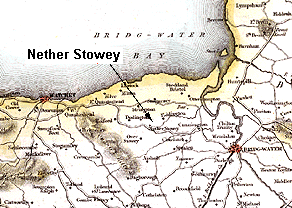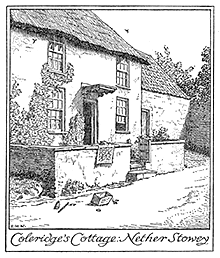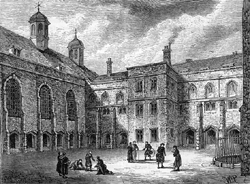
1. Short biography of Coleridge's life
Samuel Taylor Coleridge (1772-1834) was one of the poets of the British Romantic period. While his most creative output as a poet lasted only a short time -- he lost confidence in his abilities as a poet before he was 30 -- he went on to have an important career as a journalist, lecturer, literary critic, and religious thinker.
Coleridge was the youngest of ten children born on October 21 1772 to the Rev. John Coleridge and Ann Bowden at Ottery St. Mary, a small town in Devon, England. When his father died shortly before his ninth birthday, Coleridge was granted a place at Christ's Hospital School in London as the orphan of a clergyman. At first homesick and terrorized by the headmaster, the Rev. James Bowyer, Coleridge developed a precocious scholarship, and had read thoroughly in philosophy before he entered Jesus College, Cambridge in 1791. Here he fell into debt, and ran away to join the army, from which his brothers had to extricate him. But he failed to complete his studies at Cambridge.
After meeting Robert Southey at Oxford in1794 Coleridge took up the cause of radical politics, and with Southey and others planned to emigrate to America to found an ideal colony. In preparation Coleridge and Southey married sisters from the same Bristol family: Sara Fricker became Coleridge's wife and Edith Fricker Southey's.
After Coleridge's marriage on October 4 1795 in Bristol, he settled for a short time at Clevedon, site of the "Eolian Harp," before returning to Bristol. He gave lectures on politics in Bristol and published a short-lived journal, The Watchman. He met Wordsworth about this time (probably September, 1795), and Tom Poole, a tanner with radical interests, who eventually secured a cottage for Coleridge at his village, Nether Stowey (about forty miles south of Bristol) where he moved on January 1st 1797. Coleridge produced his best known poetry while living here, including "Frost at Midnight" and "The Rime of the Ancient Mariner." He also managed to bring Wordsworth and his sister Dorothy to live nearby at Alfoxton House in July 1797. He was granted an annuity of £150 per annum by the Wedgwood brothers John and Tom in January 1798. His collaboration with Wordsworth resulted in publication of Lyrical Ballads in September 1798.
Also in September 1798 the Wordsworths and Coleridge travelled to Germany together in order to acquire a knowledge of German culture and language. Coleridge soon went his own way, attending lectures at the university of Göttingen. Returning to England in July, 1799, Coleridge decided to follow the Wordsworths north to the Lake District. He moved to Greta Hall at Keswick the following year, while making regular visits to London and working as a writer for the Morning Post. But increasingly unhappy with his marriage and, suffering (although unknowingly at this stage) from an addiction to opium, Coleridge sought to recover his health by leaving for Malta in 1804. Away for over two years, Coleridge returned via Sicily and Rome. On his return he arranged a separation from his wife (Sara and his children remained at Greta Hall with the Southey family), and lived for extended periods over the next three years in the Wordsworths' house at Grasmere.
Coleridge gave the first of several important lecture series in London in 1808 on the principles of poetry (others followed on Shakespeare and Milton, on drama, and on philosophy). He moved permanently to London in 1810, having quarreled with Wordsworth. In 1815 Coleridge collected his poetry for publication: the preface he began to write developed into the Biographia Literaria (1817), and was published separately from the poetry, which appeared in Sibylline Leaves (1817). In 1815 Coleridge had put himself in the care of Dr. James Gillman in Highgate, North London, where his opium addiction was brought under control. He stayed in the Gillman house for the rest of his life. He producing other important works, such as Aids to Reflection (1825), and became known as the "sage of Highgate" for the power and influence of his conversation. His Table Talk was collected and published after his death by his son in law, Henry Nelson Coleridge.
[Biography adapted from Romanticism: The CD, ed. Miall and Wu.]

 The cottage is on the edge of Nether Stowey, a village about four miles from the coast in Somerset (see map below), in the west of England forty miles south of Bristol. It is below the Quantock Hills.
The cottage is on the edge of Nether Stowey, a village about four miles from the coast in Somerset (see map below), in the west of England forty miles south of Bristol. It is below the Quantock Hills.

The Wordsworths (Dorothy and William) lived about four miles away on the northern edge of the Quantock ridge from July 1797 to July 1798.
The view of the cottage is by Edmund H. New, from Professor Knight, Coleridge and Wordsworth in the West Country (London: Elkin Mathews, 1913), p. 58. The map is a detail taken from "Somersetshire," in Lewis' Topographical Dictionary (1831), William C. Wonders Map Library, University of Alberta.


My cradled infant. Hartley Coleridge was born on September 19th, 1796, thus he was about 16 months old when the poem was written in February 1798. Coleridge was delighted by his birth, and observed his growth carefully. His notebooks and letters contain a number of observations on Hartley's behaviour and sayings as a young child. One specific episode formed the conclusion of the first version of the poem, removed from later editions. See first version (click on the Back button to return).

It has been argued by Paul Magnuson that in publishing "Frost at Midnight" in 1798 Coleridge was drawing attention to his state of settled domesticity away from the radical centres of Bristol or London: that is, the poem was a signal to his enemies that his days of political agitation were over. (To Magnuson: click on Back button to return)


And makes a toy of Thought. Lines 19 to 23 were the lines most heavily revised in successive versions of the poem. Coleridge is saying here that he identifies with the fluttering film of ash on his fire: because it seems alive it provides him with a companion. At the same time, compared with the "abstruser musings" he was formerly engaged in, this makes a "toy of Thought," that is, it trivialises his thinking.

How oft, at school. Shortly after his father died, Coleridge was sent to Christ's Hospital School at the age of nine: in July 1782 to the preparatory school at Hertfordshire north of London, then in September to the main school near Holborn in central London. He appears to have lived almost exclusively in London thereafter. He experienced severe home-sickness and as a young boy was terrorized by the headmaster, the Rev. James Bowyer. All his life Coleridge was haunted by nightmares relating to his early years at the school, and he referred to his sufferings there in several poems in addition to "Frost at Midnight."

Of my sweet birth-place. Ottery St. Mary, near Exeter in southern Devon. Coleridge's father, John Coleridge, was minister of Ottery St. Mary church. The family lived in a house adjacent to the church.

preceptor. Teacher. Probably a reference to the headmaster, the Rev. James Bowyer. For an account of his teaching methods, see Coleridge's Biographia Literaria (1817), Chapter 1 (Collected Coleridge edition (1983), ed. J. Engell and W. J. Bate, Vol. I, pp. 8-11).

clothed alike! At this time young boys and girls were both clothed in long frocks. A boy was "breeched" at about the age of seven, that is, put in breeches. Coleridge's sister Ann (or Nancy) died in 1791.

pent 'mid cloisters dim. Another reference to Christ's Hospital School. The cloisters surrounded the yard where the children gathered during recess. As the view in the print below shows, the yard seemed like a prison.


mountain crags. This description is probably taken from Wordsworth's conversations about his upbringing in the Lake District, a place that Coleridge had not yet visited. The lakes there do not have sandy shores.

February, 1798. After 1828 Coleridge omitted this date from editions of his poetry.
